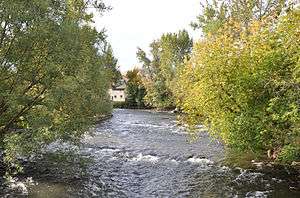Wallowa River
| Wallowa River | |
 Wallowa River at Wallowa, Oregon | |
| Name origin: A Nez Perce word for a triangle of stakes forming part of a fish trap[1] | |
| Country | United States |
|---|---|
| State | Oregon |
| County | Wallowa and Union |
| Tributaries | |
| - left | Lostine River, Minam River |
| Source | Confluence of the east and west forks of the Wallowa River |
| - location | about 1 mile (1.6 km) south of Wallowa Lake, Wallowa County, Oregon |
| - elevation | 4,499 ft (1,371 m) [2] |
| - coordinates | 45°16′28″N 117°12′42″W / 45.27444°N 117.21167°W [3] |
| Mouth | Grande Ronde River |
| - elevation | 2,316 ft (706 m) |
| - coordinates | 45°43′31″N 117°47′09″W / 45.72528°N 117.78583°WCoordinates: 45°43′31″N 117°47′09″W / 45.72528°N 117.78583°W [3] |
| Length | 55 mi (89 km) [4] |
| Basin | 950 sq mi (2,460 km2) [5] |
| Discharge | for Wallowa |
| - average | 610 cu ft/s (17 m3/s) |
| - max | 4,640 cu ft/s (131 m3/s) |
| - min | 89 cu ft/s (3 m3/s) |
|
Location of the mouth of the Wallowa River in Oregon | |
| Wikimedia Commons: Wallowa River | |
The Wallowa River is a tributary of the Grande Ronde River, approximately 55 miles (89 km) long, in northeastern Oregon in the United States. It drains a valley on the Columbia Plateau in the northeast corner of the state north of Wallowa Mountains.
The river begins at the confluence of its east and west forks, which rise in southern Wallowa County, in the Eagle Cap Wilderness of the Wallowa–Whitman National Forest. It flows generally northwest through the Wallowa Valley, past the communities of Joseph, Enterprise, and Wallowa. It receives the Minam River from the left at the hamlet of Minam. Continuing north another 10 miles (16 km), it joins the Grande Ronde along the Wallowa–Union county line about 10 miles (16 km) north-northeast of Elgin and about 81 miles (130 km) from the larger river's confluence with the Snake River.[4]
The Wallowa Valley was home to Chief Joseph's band of the Nez Perce Tribe. Chief Joseph asked the first white settlers to leave when they arrived in 1871.[6] The U.S. government expelled the tribe and seized their property and livestock in 1877,[6] when non-Indian farmers and ranchers wanted to settle the fertile Wallowa valley. The tribe was barred from returning to their homeland by the government after repeated petitions. The tribal members were shipped in unheated box cars to Indian Territory (now Oklahoma) to be placed in a prisoner of war camp never to see their home again.
Fish
The Wallowa River supports populations of steelhead, spring Chinook salmon, and mountain whitefish among other species. Sockeye salmon were extirpated from the Wallowa River when a small dam was constructed at the outlet of Wallowa Lake in the headwaters of the river. The dam was constructed to raise the level of the lake to store water for irrigation.
See also
References
- ↑ McArthur, Lewis A.; McArthur, Lewis L. (2003). Oregon Geographic Names (Seventh ed.). Portland, Oregon: Oregon Historical Society Press. p. 1006. ISBN 0-87595-277-1..
- ↑ Google Earth elevation for GNIS coordinates
- 1 2 "Wallowa River". Geographic Names Information System (GNIS). United States Geological Survey. November 28, 1980. Retrieved July 1, 2009.
- 1 2 United States Geological Survey (USGS). "United States Geological Survey Topographic Map". TopoQuest. Retrieved July 1, 2009. The maps, which include river mile (RM) markers from the mouth to the downstream end of Wallowa Lake at RM 50 or river kilometer (RK) 80, cover the following quadrangles from mouth to source: Rondowa, Howard Butte, Minam, Wallowa, Evans, Lostine, Enterprise, Joseph NW, and Joseph.
- ↑ "Boundary Descriptions and Names of Regions, Subregions, Accounting Units and Cataloging Units". U.S. Geological Survey. Retrieved August 22, 2010.
- 1 2 Deumling, Dietrich (1972). The Roles of the Railroad in the Development of the Grande Ronde Valley. Flagstaff, Arizona: Northern Arizona University. pp. 5, 7. OCLC 4383986.
External links
- Grande Ronde Model Watershed
 Media related to Wallowa River at Wikimedia Commons
Media related to Wallowa River at Wikimedia Commons